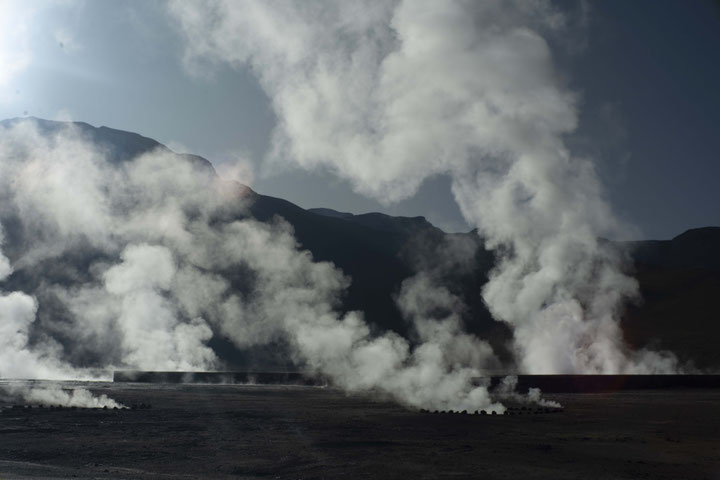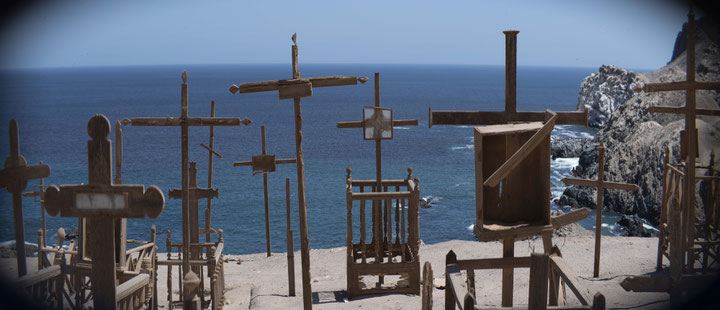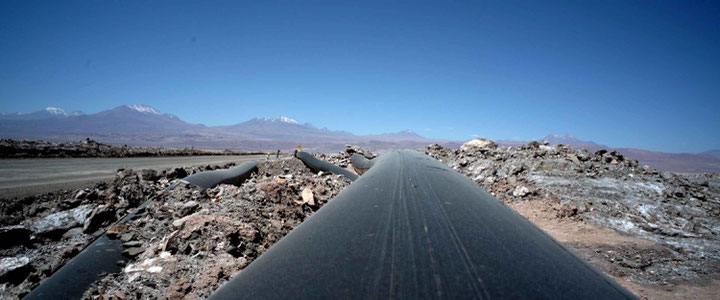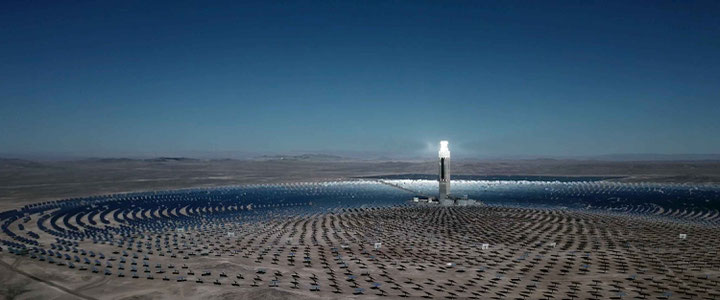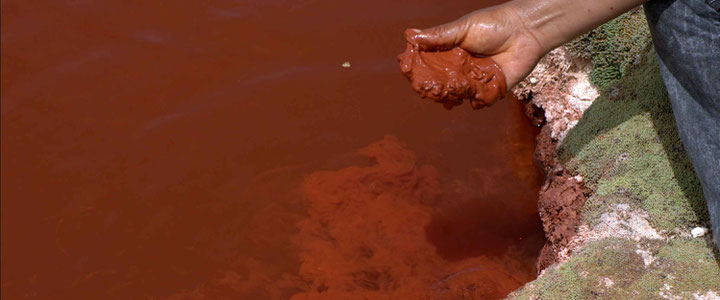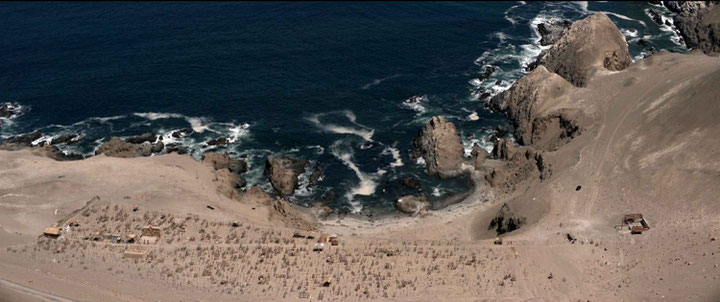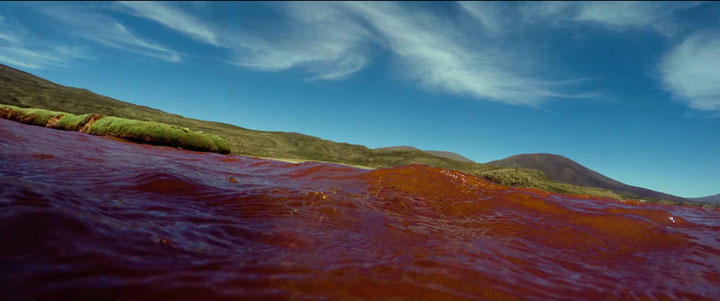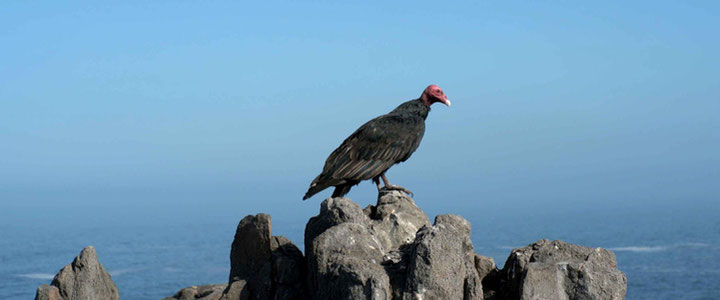Issue 4/2023 - Imperiale Gewalt
Violence and Mineral Solidarity
In Conversation with Denise Ferreira da Silva and Arjuna Neuman about their new film Ancestral Clouds Ancestral Claims
In 2016, philosopher Denise Ferreira da Silva and filmmaker Arjuna Neuman joined forces to launch a project titled “elemental cinema”. Since then, a series of four films has been produced which is focused on the classic elements of water, fire, air, etc. to illustrate a fundamental shift in perspective: away from subject-centered, “human” points of view, towards a political-ethical sensorium based on the inseparability of everything material and “elementary”. Ferreira da Silva’s previous confrontations with racism and “unpayable debt”1 are as congenially part of this as there are visual approaches to material or “mineral” entanglements. In conversation, they explain their ethico-aesthetic approach by way of the example of their latest film, which uses the element of air/wind/clouds to lay out a critical vocabulary about imperial violence.
CH: The new film you are showing at Kunsthalle Wien, which is titled Ancestral Clouds Ancestral Claims, is aiming at a kind of double articulation. It’s a deep investigation of one of the classical Greek elements, namely air, by means of instantiations like wind or clouds. On a second level, what we see is a politicization of this very physical element, which is done by pointing towards certain historical claims – ancestral demands that should be mapped onto this elementary level. Can you explain why you think politics should start off from such a fundamental geological level?
DFS: It’s not so much that we have a double articulation here but rather a kind of collapsing – of “claims and clouds”. What we are proposing in that gesture is to think of the claims made by those who have been subjected to colonial and racial violence as claims that do not fit what the historical can convey. Instead of historically, we read those claims as atemporal – atemporal like the elements, both the classic Greek elements, but also elementary particles, which are cosmic and quantic and beyond the limitations of time. That is, we read them materially, or elementally.
AN: Another way to phrase this is that politics in its human cultural form has, for the longest time, been separated from the environment. One of the things we try to do is to start from a place where that fundamental separation isn’t taken for granted.
CH: There are several narrative dimensions and documentary layers to Ancestral Clouds Ancestral Claims. The most outstanding is, first, the literary story told by a cast of characters named “Common Winds”, “Omer” and others, which is an oral travelogue, passing through different geographies and landscapes, from the Sahara to encounters in the Atacama desert. Second, there’s a vast visual mapping of different sections of the Atacama desert. What made you combine these two layers – the documentation of a very particular place, and the kind of storyline that cuts across different continents and cultures?
AN: We took air and wind as our central element for this film, and one of our main questions is: what is carried on the wind? What does a cloud hold? Some of the things that we came up with are dust, pollution, microbiology, and bacteria. But then there is also poetry, ideas, fragments of stories, and we thought about the way this kind of knowledge travels all the way up and down the Pacific, from Chile to Vancouver and beyond. The film is mostly focused on Chile but we were imagining how phrases, poems and fragments you might hear in passing are caught on the wind. We wanted to recreate that but not in a linear narrative. It’s more a composite of encounters, some of which actually happened, and some of which are semi-fictionalized – all in the form of “what is carried on the wind.”
DFS: It’s a composition that allows us to highlight the inseparability that’s crucial to the ways in which we go about doing our films through and with the elements – the “Common Winds” are the winds over the Pacific, but also the winds over the Atlantic. At some point, the dust from the Sahara that passes through the Amazon ends up in the Andes. To highlight that, the forms of storytelling or presentation we choose are different: beginning in one particular place, and using everything else as a kind of fog or dust storm that makes it to other places.
CH: What is extremely striking about the film is that it presents not only what has already become partially known about the Atacama desert in recent years, namely the vast aggressive procedures of lithium or copper extraction, the massive “terraforming force” at play there. But you also point out other layers not so well-documented, namely the huge telescopes for space observation stationed there, and that lots of victims of the Pinochet regime have been buried there. We see images of vast cemeteries, largely unmarked graves as well as other imagery that might be interpreted as human remains. Are these different tragedies – the extractivist, the astrophysical and the political/dictatorial one – intricately linked to each other, or do they just happen to be co-present in the same area?
DFS: In all our films what you see is precisely this constitutive connection between extractivism and political violence – political violence considered in a very general and global way, starting from colonial conquest through totalitarian regimes, dictatorships, fascism, police brutality, and so on. The Atacama, and then also ALMA, signify capital’s consistent dependency on and orientation towards mining, not only to the resources in the ground but also what’s out there in the cosmos. This is also a reference to the element Air’s correspondence to knowledge, in technology, and to the ways of describing different kinds of spaces.
AN: In an earlier film, we looked at the crystal, a kind of quartz, which was one of the earliest objects that was collected and accumulated. It is also one of the few objects in nature which has symmetry in straight lines, which made us think of the double meaning it carries: both the beginning of accumulation, and the beginning of geometric rational thought (and connected to it, the many optical metaphors as a defining feature of knowledge). This was our starting point: to think of ALMA2 as one side of a crystal, and resource extraction as the other.
The large hole in the ground, by the way, is where they found an unmarked grave. There are many that haven’t been found, and many relatives of victims of the Pinochet regime are still searching. The one we show in the film happens to be close to the Pacific, which, as you know, was used during the Pinochet regime to dump bodies. Bu this one is accessible, there’s a memorial there and it has the names of all the people who died there. Unmarked graves have been a constant interest in our films: from sunken slave ships (like in our first film Serpent Rain) to the Soot Breath – Corpus Infinitum, where we filmed an unmarked grave from the genocide in Indonesia.
CH: Aerial views shot with drones were necessary in that respect, namely to map out these vast territories?
AN: I think if you’re making a film about wind, it makes sense to inhabit the perspective of wind. But also, in order to see the vastness of the lithium mines, you need this high perspective. When you’re there on the ground, you just see piles of salt. You get a sense of the scale, but you can’t really see that scale until you go up to 500 or 1,000 feet.
CH: Coming back to the issue of violence, do you think that the different kinds of violent scenarios that the film points out – extractivism, political repression and annihilation of regime opponents, the widespread violence against migrants – can all be attributed, or traced back, to the same kind of mindset? Or are we dealing with vastly different existential realms here?
DFS: What the film first and foremost allows us to do is to explore visuality, which is central to this mindset. The most sophisticated term I have for it is to mess up assumptions about separability, which has been necessary precisely for the kind of knowledge mentioned before: symmetry, separability, etc. Film can do that because, in addition to addressing us in terms of what we know and how we think, images can also make us feel in a certain way. Through this very “thinking-feeling” moment, sensibility as the traditional concept of capturing the aesthetic can be shifted or messed up.
AN: I think it doesn’t all come down to one mindset or ideology. The crystal example might be one significant route, but it’s not the only route. The way capitalism extracts and enacts violence in different parts of the worlds cannot be reduced to one single frame of mind. I think it’s a much more complex thing we are dealing with.
CH. There are chapter titles in the film that are quite revealing in this respect, namely when it comes to subsuming different kinds of violence under a common term: for instance, the concept of the “sacrifice zone” is standing out and could be taken as a designator for the wastelands of the “racialized neoliberal capitalocene” (if one can call it that). Do you think a major task we are facing here is giving names to the “unnamable”?
AN: “Sacrifice zone” is actually official language. It is used by the Chilean government to designate territories which can be turned into wastelands. I think most governments have parts of either inside their country, or parts of an ex-colony, which they designate as places which can be totally exhausted.
DFS: I don’t know if this is really about “naming” because naming implies a sense of limiting and that is exactly what we are trying to avoid. The titles we use allow us to highlight what’s there in a lot of different places, but which is otherwise not perceptible unless we actually come up with certain descriptions. They do not name specific sites but it’s somewhat more generalized.
CH: What I could not quite figure out is the idea (and also chapter heading) of “immortal accumulation”, subtitled: “what the vultures see”. The imagery that comes along with it are ruins, huge water pipelines, geysers etc., while on the soundtrack, we hear stories about copper phone-wires and indigenous myths about flamingo feathers. What exactly is “immortal accumulation” aiming at?
AN: There’s a passage in the film where we talk about mining and what it’s for, and we say, copper is for circuitry, salt is for icy roads, and at the very end: the soul is for posterity. This idea is responding to Margaret Thatcher who famously said, “economics is the method, the object is to change the soul”. The connection between capitalism and the production of subjectivity is the space in which multiple accumulation becomes possible to the point where we know we’re exhausted because we are constantly being extracted from, and it’s only ever increasing. Once the soul becomes the mine, we are in serious trouble.
CH: A counter-concept to the “racialized neoliberal capitalocene” might be the idea of “mineral solidarity”, which is the title of the concluding chapter of the film. This notion is not so much connected to the earthly territory, but in the perspective that the film projects, to the “hold of the wind” – what clouds and the wind carry, which is also designated as a “migrant ecosystem”, as the voice in the film explains. What exactly is it that clouds might carry, beyond possible devastation or the epitome of the climate catastrophe?
AN: We have two phrases here that point towards the same thing, and the way you phrase it is exactly right. If, on the one hand, you think about the nuclear cloud as the prototype of the climate catastrophe, that kind of an all-encompassing cloud is something to be very afraid of. At the same time, the cloud is where all of our senses are most blurred in the way that we can’t really see, we can only taste it, we can feel it on our skin. We have a sensory experience of indistinction and I think that’s a possible idea of solidarity – a sensory solidarity, both within ourselves and beyond people. The other idea is that of dead slaves, or Marxists, or dissidents, whose mineral matter gets carried up into the cloud and meets cosmic, stardust, plastics, microplastics, bacteria etc. In the cloud you have a kind of swirling migratory ecosystem, which evokes another model of solidarity that borrows from more traditional notions but thinks of it in an expanded planetary or interplanetary way.
DFS: On the one side, we have “mineral solidarity” which is signaling a different kind of political positioning – one that does not refer to hierarchies or to salvation or redemption. It also doesn’t recall moral distinctions that make any kind of collective/collaborative work globally impossible. On the other side, there is a descriptor for existence, which we can call elemental sociality, and which signals the same kind of connection. So “mineral solidarity” would be the ethico-political basis while elemental sociality is its onto-existential descriptor for this image of existence we are speculating on here, inspired by the Air. That is, they provided a full description of an elementally approached political position.
CH: At the very end of the film, we not only see clouds of tiny, mineral-like particles forming certain clusters and shapes, but also the shadowy figures of Black people on a slave ship that crosses the ocean. In some respect this connects back to the first film you made together, Serpent Rain, in which the imagery of a Norwegian slave ship is invoked. What particular “ancestral claims” do you regards as legitimate in this respect, considering the history and on-going aftermath of slavery? Is it a matter of mere recognition, of material reparation, or a much more radical turn-over of the existing (Western, still mostly liberal) system?
DFS: That’s the kind of work to be done, and it involves a radical reconfiguring of our whole imagination, and along with that, our sensibility and thinking. The “claim” should not be understood as an anthropological one, nor as a biological one, nor a historical one, or universal, but as an elemental one, that is, a claim that assumes the inseparability of everything, not only human, but also what is nonhuman in all of that. The demands that are made under the conditions that we actually live in can easily be comprehended in misleading ways: for instance, when demands for reparations from slavery are made in the US, the answer is usually: ‘why should we pay you back, we didn’t enslave anyone.’ Or if demands for the recognition of indigenous land are made, the answer is: ‘why should you have the land, you didn’t develop it.’ Here we have two kinds of differentiations, which are biological and historical. But when such claims for reparations from enslavement, or the claims for the return of indigenous lands or objects held in European museums are recognized as ancestral claims, then there is also an acknowledgment of the inseparability between those who make these claims, and the things that are here and now, out there. And not only the actual things, but everything that has been made possible because of extraction, the original displacement and expropriation. So, it is a demand for the restoration of everything – a mandate that carries both utter necessity and absolute impossibility. If this inherent contradiction, which renders any attempt at fulfilling this mandate lacking, falling short, becomes the basis for considering actions and decisions regarding addressing colonial and racial violence, the very concept of justice will radically change. Justice, in this way, is no longer envisioned on the basis of a formal (transcendental or even universal) principle. Instead, justice would finally be seen as material, in the sense of acknowledging how everything and everyone is deeply implicated, that is, inseparable at the level of our elemental (quantic/cosmic) composition.
CH: A crucial role in the theoretical background of your filmic practice is played by the Western philosophical concept of “I am” (reaching back to Descartes and Kant’s “transcendental apperception” of the ego). According to your ongoing and substantial critique, this concept has been mainly responsible for delimitating the free, liberal Western self from everything that surrounds it, and thus also from “lifeforms” or “non-life” which are usually deemed as less valuable. Do you think all forms of epistemic, but also racial or imperialist, violence can ultimately be traced back to this founding notion of the allegedly “transparent, self-affirming self”, which is also deeply implicated with whiteness and masculinity? Is this the root of all evil?
DFS: I think what made it possible for that figure to govern our existence so efficiently and such a long time, is the root of all evil. But we should not really use that phrase because that’s not how I think. What you describe of course accounts for the centrality of violence in our thinking and what makes that possible is something I’m calling linearity these days: a linearity, which is metaphysical (in the sense Derrida uses when he describes metaphysics of presence). That is, by linearity I refer to the line in both senses, the one that gives the sense that something is present and remains present and the line that gives the sense that something is separate or distinct from its environ or from something else. In a way, it corresponds to Kant’s postulate of space and time as formal intuitions.
CH: Following up on this notion of linearity, you seem to be deeply skeptical of the idea of historical progress (or unilinear time, for that matter). It’s “all beginnings”, or “all endings”, as it says in the film, but time as a kind continuum between beginnings and endings does not exist. How else can we arrive at some kind of progress (e.g. overcoming racism) when this very elementary kind of movement – from something worse to something better – is rejected?
AN: Well, overcoming racism is something that already exists. There is not a timeline towards it. The idea of progress, or the idea of messianic time or the kind of return or revolution that it implies, this moment of transformation – all that has, in a way, lead to immortal accumulation. The soul, or Christ, or the revolution, or however it’s figured, is very much like a dangling carrot that we’re always ever accelerating towards but that never actually appears, or if it appears then only in piecemeal. Generally, I think the idea of progress towards something better is quite dangerous … or has certainly been ineffective so far.
DFS: I have an installation in the current São Paulo biennial that is called “The Metaphysics of the Elements – Fire: The Studio”. It’s a studio that shows how the end of the world happens everywhere, all the time. As Arjuna says, we have everything that we need to stop the violence, that’s not a place to get at. What we need to do is just do it here and now, but differently: bring about the end of the world in all those places, in all those gestures, in each decision that we make.
CH: An important notion that comes up in the film is the one of something “hiding in plain sight”. The kind of solidarity across different regions and elementary realms that you aim at is described this way – as something that’s already there, but at the same time, we cannot fully see it or bring it out for the common good. At the same time, the notion seems to apply to a lot of other, not so positive processes as well, like the long disastrous history of racial discrimination, or the climate catastrophe, which are also “hiding in plain sight.”
AN: We certainly mean both. I think the unmarked graves are one of the foundational points of the neoliberal “hidden in plain sight” – from offshore banking to maquiladoras to black-ops sites to people being disappeared to all kinds of political violence that happen just below the threshold of what is legal but often state sanctioned. What’s hidden in plain sight is so much violence, that’s true. But at the same time, what is also hidden in plain sight is the potential reparative, minimal solidarity, elemental sociality.
DFS: The image we have of the political subject today – which is addressed as subjectivity – but also in the last 20 to 30 years, is that of a collective that is identified in a certain way and whose present social conditions result from a particular history of subjugation. The demands made by subjugated groups can accordingly only be understood in terms of their socio-historical particularity, which also account for their identity as such, as a separate collectivity. In this light, if demands are made on the basis of “mineral solidarity” or “elemental sociality,” they obviously make no sense, right? Because there is no separating line here, there is no line of identity, no (continuous) line of history or the (heterogenous) grid which is society. Under mineral solidarity, this social and historical specificity that now seems natural aspect of the proper ethical-political subjectivity are displaced or decentered. Hidden in plain sight then refers not so much to that which exists, but how we make sense of what exists and happens, how we describe it, and the connections that become possible. Everything exists and is implicated elementally (as minerally), we just don’t pay attention to that.
CH: You state in the accompanying essay to the film that decolonization has to be considered as “the only ethically relevant principle of today”3. The kind of decolonization you have in mind does not seem to take its exclusive departure from colonized subjects (or “ex-colonials”) but appears to be premised on a much larger basis, one that takes into account the history of slavery and colonialism, but also focusses on extractivism, all sorts of imperialist violence, the powers of neoliberalism etc. Is there a sort of bounded, oversee-able basis of what decolonization should target on the whole?
DFS: I did kind of answer that before when I was talking about the restoration of all that’s been extracted and expropriated under conditions of colonial and racial violence – that’s what I mean by decolonization. When that becomes the demand, then it also becomes another name for justice, which means several things: first, that this return should be taken seriously as a mandate, and that everything should be done towards meeting that impossible demand. If that becomes the mandate then everything else shifts and what emerges is also a new point of departure for thinking of justice and recognizing demands under that name. Everything comes together “later” in a way – not temporarily later, just logically later, because that’s the kind of “first” demand.
CH: You frame your artistic approach as “elemental cinema” (in the full ambiguity of the term) and you have covered three elements in your films so far. Do you already know what the next move will be after fire, the one still missing, has been covered as well? Are there more candidates of “elementary” issues?
AN: I think there could certainly be more elements. The name for the series comes from a question raised at the end of Serpent Reign: What would become of humans if expressed by the elements? Elemental cinema is our way of thinking through this question and I don’t think we’ve exhausted the answers to it. After fire, there are several options. One is to start over again and go back to water, earth, etc. Or we could add ether, or move to elemental particles, or visit other taxonomies like the Chinese one that considers wood and metals as “elements” as well. But we still have to get through fire first.
Ancestral Clouds Ancestral Claims is on view at Kunsthalle Wien Karlsplatz until March 17, 2024; https://kunsthallewien.at/en/exhibition/denise-ferreira-da-silva-arjuna-neuman/
[1] Cf. Denise Ferreira da Silva, Toward a Global Idea of Race. University of Minnesota Press 2007, and Unpayable Debt. Sternberg Press 2022.
[2] The Atacama Large Millimeter/submillimeter Array (ALMA) is an international radio telescope observatory in the northern Chilean Andes.
[3] Denise Ferreira da Silva, Ancestral Claims, in: Denise Ferreira da Silva & Arjuna Neuman – Ancestral Clouds Ancestral Claims, Exhibition Guide, Kunsthalle Wien, 2023, p. 32.
